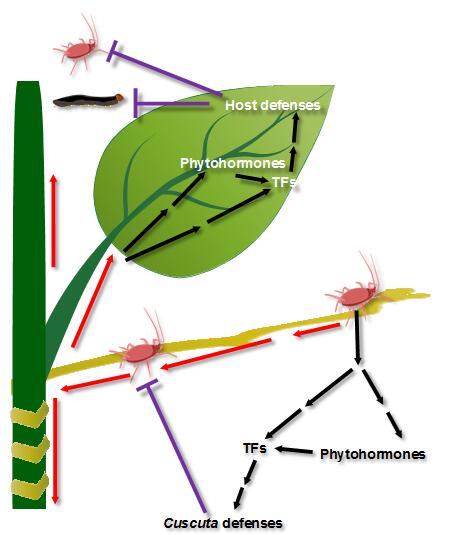It has long been known that when a plant is attacked by herbivores, defense responses are generated, which travels from the wounded organ to other parts of the plant that thwarts further attack by the herbivores. Many parasites, especially the holoparasitic ones, usually have highly altered morphologies, special ecology, and evolutionary histories. How parasites respond to insect herbivory and whether the connected host plants also have defense-related reactions were unclear.
Cuscuta spp. (dodders) are shoot holoparasites, whose haustoria penetrate host tissues to enable fusion between Cuscuta and host vascular systems allowing Cuscuta to extract water, nutrients, and various other molecules from hosts. Aphids are typical piercing-sucking insects, and they use their specialized styles to obtain phloem sap.
A research team led by Prof. WU Jianqiang, a scientist at the Kunming Institute of Botany of the Chinese Academy of Sciences (KIB/CAS) recently discovered that when a Cuscuta plant is attacked by aphids, defense responses are induced in Cuscuta and a systemic signal is translocated to the host and activates defenses therein.
Specifically, the research team showed that the feeding of green peach aphid (GPA) Myzus persicae on Cuscuta australis induced phytohormonal responses in C. australis and the soybean hosts. Both C. australis and soybean hosts responded to GPA feeding with transcriptomic reconfigurations.
Moreover, insect bioassays indicated that aphid herbivory on C. australis induced the resistance of soybean hosts to insects Spodoptera litura and Aphis glycines.
This study demonstrates that aphid feeding on dodders activates defense responses in both the parasites and hosts, resulting in increased defense in the host plants against subsequent insect herbivores, and this may provide certain benefit to host plants, although overall, dodders decreases host fitness.
This research has been published in the New Phytologist online in an article entitled “ Aphid Myzus persicae feeding on the parasitic plant Cuscuta australis (dodder) activates defense responses in both the parasite and soybean host".
This work was primarily supported by the Strategic Priority Research Program of the Chinese Academy of Sciences, the Max Planck Partner Group Program, and the National Natural Science Foundation of China.

Fig. 1. A working model depicting the responses induced by aphid feeding on Cuscuta. (Image by KIB)
Aphid feeding on Cuscuta elicits changes in phytohormones, such as JA and SA, and transcriptomic reconfigurations, which are mainly regulated by transcription factors (TFs), leading to accumulation of defensive metabolites in Cuscuta. Aphid feeding also activates a well-conserved mobile signal (red arrows), which travels along Cuscuta vines and thereafter reaches the host. Transported by the vascular systems, the systemic signal moves to different parts of the host and activates accumulation of phytohormones and transcriptional regulation of TFs, and these lead to transcriptomic changes in the host and finally increased defensive metabolites. Black arrows indicate signaling or regulatory pathways.
Contact:
YANG Mei
General Office
Kunming Institute of Botany, CAS
Email: yangmei@mail.kib.ac.cn
(Editor: YANG Mei)




